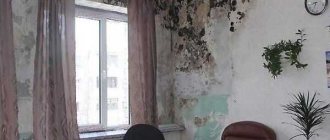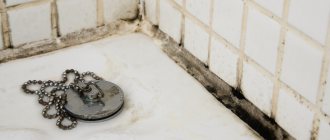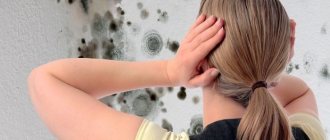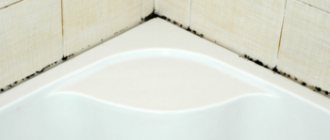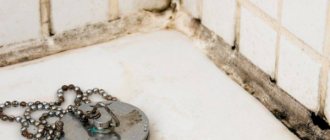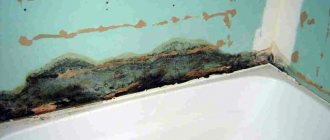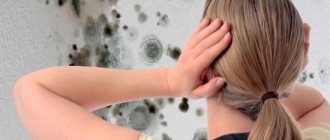Mold in the bathroom is a common occurrence that many have probably encountered. There can be many reasons for its appearance, but the main one is high humidity. Of course, its appearance will not please many people; it not only spoils the appearance of the walls of the room, but also has a harmful effect on health. Therefore, as soon as the first fungal stains begin to appear on the tiles in the bathroom, they must be immediately treated with special means. We will tell you in more detail how to clean mold on tile joints and what is used for this.
Causes of mold
Many people often ask why fungus often occurs in the bathroom? After all, it seems that everything is done to ensure cleanliness and order - cleaning, washing floors and walls, using special detergents. But fungal stains still appear again and again, and they cannot be cleared. First, it’s worth finding out the causes of mold:
- it is possible that when installing the tiles the relevant standards were not followed and mistakes were made;
- poor ventilation in the room;
- reduced temperature in the bathroom;
- poor quality cleaning of the premises;
- high level of humidity;
- Carrying out constant water procedures - drying things, washing.
Often, mold spots appear on tile seams, which greatly spoil the aesthetic appearance of the room. But do not forget that the fungus has a serious impact on health and can cause serious consequences. Therefore, when stains are first detected on the seams, treatment must be carried out immediately. For removal, you can use a special antifungal primer mixture. The seams are thoroughly wiped with a primer until the stains are completely removed. They can be covered with grout on the sealant.
In addition, the bathtub and toilet must be ventilated after taking a bath or shower or washing. To do this you need to open the door. It is advisable to install a fan in the ventilation duct to blow air into the room. Due to this, moisture will disappear faster.
It is good if the room has a hot heated towel rail or radiator. If these elements are missing, then a heater can be installed there to warm the room. It is also necessary to do cleaning using detergents that protect the tiles from fungal and mold stains.
Why does mold form?
To understand how to remove mold in tile joints, you need to understand the reasons for its appearance. No special conditions are required for the fungus to multiply.
Traces of mold in the bathroom
It only needs moisture. That is why the ideal place for the formation of mold colonies is the bathroom.
The decisive factors for this phenomenon include:
- poor ventilation, which contributes to the formation of moisture;
- leaking pipes and plumbing;
- drying wet laundry;
- cast iron pipes on which condensation forms;
- poor location of the bathroom, which contributes to the formation of excessive dampness;
- poor quality waterproofing of surfaces;
- lack of natural light (ultraviolet radiation destroys fungal spores).
In the old days, mold was an infrequent guest in residential buildings. Wooden windows and doors allowed air to circulate, providing good ventilation.
Therefore, people rarely thought about how to remove mold between tiles in the bathroom and other rooms.
The installation of plastic windows and sealed doors increased the sound insulation of the premises, but led to the formation of condensation, which caused extensive growth of fungus.
Places where mold stains occur
We seem to have figured out the reasons, now it’s worth finding out in what places spots of black or green fungus may appear. This will simplify the work and also save processing costs.
In the bathroom, fungal accumulations often appear in places:
- black or green spots often fill the seams of the tile covering;
- fungus may appear in the corners of the room;
- at the junctions of walls;
- Sometimes mold can be found in the shower stall, between the shelves, in any spaces between cabinets and walls.
Mold in the faucet area
Mold in the corner of the room
Basically, fungal spots appear in places with increased moisture accumulation. During the cleaning process, be sure to thoroughly wipe everything and check for mold stains.
Bleach or white will remove fungus in the bathroom
You can remove fungus from the ceiling and walls with bleach. Don't forget about gloves and a respirator.
- Add bleach to the water in a ratio of 1:10.
- Distribute the resulting solution with a sponge or spray.
- Do not wash off the bleach; it will prevent rot from reoccurring.
- Ventilate the bathroom.
Ways to get rid of mold
Of course, the best way to get rid of mold and fungal stains is to prevent them from occurring. But if they do appear, then it is necessary to immediately begin cleaning them.
The grout between tiles can be cleaned in many ways. But before processing, it is necessary to prepare special mixtures for cleansing. The following products can be used against mold stains:
- household chemicals that contain chlorine. Household chemicals include “Belizna”, “Domestos” and products that contain chlorine. These mixtures are excellent helpers in the fight against mold. They not only remove it well, but also disinfect areas. In the future, mold spots do not appear in areas treated with chlorine-containing mixtures;
Household chemicals with chlorine
- special antifungal drugs designed to combat mold at home. One of these products is Polymix. This mixture contains a microbiocide in the form of quaternary ammonium. The drug has a destructive effect on all kinds of fungi, mold, pathogenic bacteria and microorganisms;
Polymix
- baking soda;
- alcohols and alcohol-containing compounds;
- antiseptic agents - hydrogen peroxide, potassium permanganate;
- products containing strong acids – acetic, oxalic;
- copper sulfate.
Folk remedies for mold
Professional method of combating mold using microwaves
The microwave method is based on the action of centimeter and millimeter frequencies, which lead to heating of the surface.
The letter combination microwave itself is probably familiar to almost everyone - this is what is sometimes called a microwave oven that operates precisely on this principle. Of course, it is not this device that will be used to combat mold, but a special microwave apparatus. With its help, those surfaces that need to be treated are heated, and they are completely dried, and all mold spores die from the high temperature. Without relying on subjective indicators, humidity and temperature during processing are measured with a moisture meter and pyrometer, respectively.
The advantages of this technique are as follows:
- rapidity;
- depth of influence;
- safety;
- the ability to penetrate hard-to-reach places;
- high efficiency.
There is only one downside - such a device is quite expensive and is not one of the frequently purchased devices. In order to use it, you need to contact specialists, and this costs money. However, this approach guarantees high-quality work and complete treatment of the room, after which mold will be completely defeated, because the craftsmen know all the intricacies of their craft.
A microwave device guarantees the destruction of mold by heating and drying surfaces
Cleaning process
The cleaning agent has been selected, now it’s time to prepare the necessary equipment for processing:
- To make work easier, the seams can be cleaned with a toothbrush. For these purposes, use an old unnecessary brush;
- cloths for wiping;
- many products can have harmful effects, it is better to use a respirator;
- To prevent the skin of your hands from being damaged, you can use rubber gloves;
- container for diluting the cleaning mixture;
- a spray bottle for spraying the mixture onto tile joints with fungal stains;
- sponge with a hard surface;
- thin brush;
- bucket.
Let's get started with the bathroom treatment itself:
- It is advisable to carry out the treatment with a special mixture to combat fungi and mold. The packaging of the mixture should clearly state that it is intended to combat mold and mildew;
- You can get rid of mold stains using products containing chlorine - Domestos, SiF, Silit and Belizna. These cleaning mixtures can remove even black stains;
- pour the product into a spray bottle and spray it on the wall with tiles. Leave for a while, 20-30 minutes;
- then everything needs to be cleaned with water and a cloth;
- if the treatment is carried out with baking soda, then it can take a lot of effort and time;
- to do this, it should be poured into a small cup;
- Wet the toothbrush a little with water and put a little baking soda on the bristles;
- then you need to clean the seams of the tile covering with a brush and soda. Cleansing is carried out until the stains are completely gone;
- alcohol and antiseptic preparations are used for cleaning using a spray bottle;
- the solution is sprayed onto the seams and wiped with a cloth;
- You can get rid of mold stains with vinegar. Moreover, this remedy can be found in everyone’s home;
- You need to pour half of the water and the same amount of acetic acid into the spray bottle. Everything is mixed well;
- the mixture should be sprayed onto the seams of the tiled walls in the bathroom;
When cleaning walls from mold, be sure to use a respirator.
- after a while you need to clean the fungus with a brush or sponge;
- When finished, you should remove everything with water and a damp cloth;
- processing can be done using copper sulfate;
- To do this, copper sulfate in the amount of 50 grams is poured into a bucket, 5 liters of water are poured in;
- This mixture is used to lubricate the spaces between the tiles. For lubrication, use a thin brush;
- leave the mixture for 2-3 hours. After that, we clean and rinse everything.
Painting
Painting the joints between the tiles will help in two cases:
- The grout has turned black due to age or exposure to light;
- The dirt has embedded itself deep into the seams between the tiles.
Painting will not help against fungus and mold. Unless you first clean them and treat the surface with fungicides.
Suitable for cement-based grout:
- Acrylic paints “Fuga Fresca”, “Pufas Frishe Fuge Komplettset”;
- Polyurethane based paints (for concrete only);
- Latex paints (perform well under large temperature changes and do not crack).
All of the above paints have excellent adhesion and are abrasion resistant. When applying, follow the manufacturer's recommendations.
Water-based paints . Such compositions have a lot of advantages: environmental friendliness, high adhesion, affordable price, large selection of colors, quick drying. However, they are sensitive to moisture and wear out quickly, so they can be a temporary solution or followed by treatment with sealant, varnish or other transparent coating.
Markers . The optimal choice for small areas of contamination with the following advantages:
- Quick application and drying;
- Resistance to moisture;
- Environmental friendliness;
- Ease of use.
This option is acceptable if the length of the seams for cleaning is 5-10 m. Please note: use acrylic-based markers . This is an analogue of acrylic paint, but more convenient to use.
Advice
When choosing a paint composition, carefully study what surfaces it is suitable for. Please choose your color carefully: it may differ slightly from that stated by the manufacturer. A win-win option is white (refreshes, harmonizes with any color) or very dark (gives originality).
Replacing grout joints
Sometimes it is not possible to clean mold using these products. Then you will have to make repairs, of course, you will not need to completely change the tile covering, but you will have to redo the seams.
How to do:
- if mold stains appear on the sealant and cannot be removed with special means, then they should be redone. First of all, we clean the mixture using a nail, spatula or other device;
- Next, you need to purchase a grease for seams with an antifungal and moisture-resistant effect. It is advisable that it be on sealant. The sealant does not allow moisture to pass through;
- Apply the mixture to the gaps of the tile covering using a rubber spatula.
Sequence of actions when replacing grout
Removing fungus from seams and tiles
Fungus that forms on the seams between tiles is more difficult to remove than on tiles. Stock up on baking soda, vinegar, a toothbrush, a thin brush and patience.
- Pour vinegar into an enamel basin.
- Using a thin brush, apply vinegar to the seams between the tiles.
- After ten minutes, it is recommended to rub all the seams with the hard side of the sponge and rinse off the remaining vinegar with water.
- Dip a damp toothbrush in baking soda.
- Clean the seams between the tiles with soda, rinse off any remaining soda with water, and wipe the tiles thoroughly.
- It is advisable to coat the tile seams with new grout.
Using an Alternative Method
As an alternative to detergents and other anti-fungal drugs, exposure can be done using the microwave method. Many note that exposure to microwaves does not have a destructive effect on the finish; in addition, mold stains can be removed using this method.
Removing mold using microwave
The thing is that during treatment, microwaves act pointwise, namely only on the affected areas. This treatment is carried out using a special device that generates electromagnetic waves and creates vibration processes of water molecules in microorganisms. This process occurs most intensively in places with high humidity. It is worth noting that fungal microorganisms consist of almost 90% water and, as a result of this exposure, their heating occurs faster, unlike finishing materials. This all ensures rapid destruction of mold.
Further, this coating will protect against the appearance of mold stains and scratches. And the walls and appearance of the bathroom will always be beautiful. Using this method you can get rid of almost any fungus. But before treatment, you need to thoroughly check the room for fungal stains.
Necessary safety measures when working to destroy fungus
Many mold removal products are toxic and poisonous, so when working with them you should follow safety precautions:
- wear gloves to protect your skin;
- wear a respirator to protect the respiratory system;
- Protect your eyes with goggles from getting dangerous liquids into them.
Protective equipment - goggles, waterproof gloves, a respirator - are required when working to remove mold.
If such liquids come into contact with the skin or eyes, the affected area should be rinsed with plenty of water and consult a doctor immediately. Even when using safe products, it is advisable to protect the respiratory system at the moment when active cleaning of tile joints with a brush is carried out, since mold spores can easily enter the body at this moment. It is also worth protecting the surfaces in the room so that mold spores do not enter and take root on them. To do this, everything that can be taken out of the bathroom should be taken out, and the rest should be covered with something dense - for example, polyethylene or a special film used in construction. Once cleaning is complete, this material should be discarded.
If the bathroom has forced ventilation in the form of a fan, it must be turned off during cleaning, since mold spores are easily picked up and carried by air movement.
All items used during cleaning - brushes, sponges, respirators, gloves - upon completion of work must be immediately placed in tight bags that exclude the possibility of ventilation and thrown away.
Prevention
Getting rid of mold stains and mildew is very difficult and sometimes causes many problems. Therefore, to prevent it from bothering you again, you should follow the rules of prevention. They will help prevent the development of this problem on the tile floor in the bathroom:
- Initially, you need to determine the cause of mold stains. Sometimes replacing the grout will solve the problem permanently. Use grout mixtures on the caulk. Fungal accumulations do not appear on the silicone coating;
- It is advisable to disassemble and clean the ventilation. It is better to install a fan on the side of the bathroom;
- You should not dry a large amount of laundry in the bathroom, because it can create a high level of humidity in the room;
- The bathroom door should be kept open at all times so that air can constantly enter the room;
- after taking a shower or bath, be sure to wipe the walls, plumbing fixtures and floors with a dry cloth;
- plumbing must be regularly checked for water leaks;
- Be sure to monitor the condition of soap dishes and cups, because these things are breeding grounds for fungus. They must always be washed and without water;
- all possible joints should be treated with sealant to prevent water from seeping in;
- Clean the bathroom periodically. You need to wash the walls and floor with water. You should also use detergents - powders, gels, whiteness. This will all help prevent mold from reoccurring;
- If there are iron pipes in the room, then it is better to replace them with plastic ones. Usually, moisture constantly accumulates on iron products.
Getting rid of mold and mildew in the bathroom is not an easy task, and it takes a lot of effort and time. To remove fungal accumulations in the bathroom, you can use various products that have an antifungal effect. The main thing is to do everything correctly, then you can remove this problem completely and permanently.
How to treat a bath if fungus has just appeared
Provided that the fungal infection in the bathroom has not reached alarming proportions, you can use folk remedies, among which the most common are:
- Vinegar. Apply to the affected surface using a sponge or spray. After treatment, let it dry, then brush off any remaining mold and rinse with water.
- Camphor balls. They are laid out in different corners of the bathroom, the effect of them is noticeable only at the initial stage of fungal development.
- Soda and vinegar. Apply a thick layer of soda to the area affected by the fungus. Then vinegar is applied to it. When the foam settles, the surface is cleaned with a warm soapy solution.
Borax processing
To treat moldy areas in the bathroom, use sodium tetraborate or borax.
- Dilute one glass of borax in two and a half liters of water.
- Wipe the moldy areas in the bathtub with the solution using an old brush.
- Wipe off any remaining sodium tetraborate with a cloth.
- It is not recommended to wash off the borax; it is better to treat the surface with a dry cloth to remove moisture.
Fungus in the bathroom on the ceiling: methods of getting rid of it
When fungus appears on the bathroom ceiling, there are only two ways to combat it. A radical method that requires capital investment. It includes the following steps:
- Using a spatula, all old whitewash and plaster are removed from the affected ceiling surface so that the floor slabs become visible.
- Prime the surface with a special antiseptic composition. In order to properly process the grooves and seams on the ceiling, it is recommended to use a brush.
- Then work is carried out on plastering, putty and re-priming the ceiling.
- Afterwards, the surface of the ceiling needs to be sanded and painted.
Removing stubborn stains
Sometimes stains and dirt penetrate so deep into the grout that it is almost impossible to clean it. Old material must be removed, completely renewing the grout.
The renewed coating will retain its color and properties for many years. You can purchase inexpensive material at any hardware store.
Creosote will remove even the most stubborn mold.
It is possible to destroy even long-grown mold with creosote, but remember that the product is aggressive and will ruin the wooden surface. Wear a respirator and rubber gloves. Fighting moldy fungi in this way is dangerous to health.
- Dilute creosote in oil or alcohol.
- Apply to mold-damaged areas of tile and grout.
- It is better to remove the remaining yellowish mass.
Darkening from rust
Typically, such contaminants form in places where water pipes are located. Dealing with fresh rust stains is easy - regular cleaning products will help.
It is more difficult to remove old stains: you will have to use store-bought products that are designed to remove rust.
If the grout has darkened thoroughly, then the product will not cope with the rust, and a complete replacement of the material will be necessary.
If the problem returns
If, despite all the measures taken to clean the sealant from mold, this could not be done, the fungus has probably penetrated into the deeper layers of the composition. To eliminate it, you will need to remove at least the top layer of waterproofing and apply a new one with an antifungal effect.
Before applying a new sealant, the surface must be treated:
- clear away debris;
- disinfect, for example, with isopropyl alcohol.
All stages of preparing and applying waterproofing must be performed very carefully. After treatment with alcohol, you need to wait 30 minutes to consolidate the effect.
Waterproofing should only be applied to a completely dry surface . After filling the seam with sealant, it is necessary to wait the required time, preventing moisture from entering its surface.
Before using the sealant, you must study the instructions for it, since different manufacturers may have their own application features.
Darkening from tobacco smoke
Very often, grout turns yellow or acquires a brown tint due to regular exposure to cigarette smoke. In this case, whitening agents and a hard toothbrush will help. Homemade remedies with baking soda work great.
One of the easiest cleaning methods:
- The seams are poured generously with warm water to soften the top layer;
- Remove surface stains with an old toothbrush for 10-15 minutes;
- Then apply soda to the brush and clean the seams very carefully;
- At the end of cleaning, wipe the surface with a sponge and clean water to wash away dirt and soda residues.
